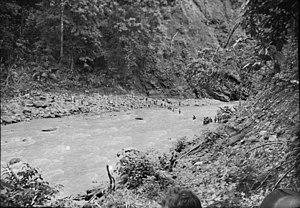Battle of Rabaul (1942)
| Battle of Rabaul | |||||||
|---|---|---|---|---|---|---|---|
| Part of World War II, Pacific War | |||||||
 Late January 1942. Australian soldiers (right centre) retreating from Rabaul cross the Warangoi/Adler River in the Bainings Mountains, on the eastern side of Gazelle Peninsula. Photographer: Sgt L. I. H. (Les) Robbins. |
|||||||
|
|||||||
| Belligerents | |||||||
|
|
|
||||||
| Commanders and leaders | |||||||
|
|
|
||||||
| Strength | |||||||
| 1,400 soldiers (New Britain) 130 soldiers (New Ireland) |
5,000 soldiers (New Britain) 3,000 – 4,000 soldiers (New Ireland) |
||||||
| Casualties and losses | |||||||
| 6 aircrew killed, 5 wounded 28 soldiers killed in action ~1,000 captured |
16 killed, 49 wounded | ||||||
The Battle of Rabaul, also known by the Japanese as Operation R, was fought on the island of New Britain in the Australian Territory of New Guinea, in January and February 1942. It was a strategically significant defeat of Allied forces by Japan in the Pacific campaign of World War II. Following the capture of the port of Rabaul, Japanese forces turned it into a major base and proceeded to land on mainland New Guinea, advancing toward Port Moresby. Hostilities on the neighbouring island of New Ireland are also usually considered to be part of the same battle. Rabaul was important because of its proximity to the Japanese territory of the Caroline Islands, site of a major Imperial Japanese Navy base on Truk.
The small Australian Army garrison in New Britain—known as Lark Force—numbered 1,400 men and was commanded by Lieutenant Colonel John Scanlan. It included just 716 frontline Australian Imperial Force (AIF) soldiers from the 2/22nd Battalion, deployed from March 1941 as fears of war with Japan increased. The force also included personnel from a local Militia unit, the New Guinea Volunteer Rifles (NGVR), a coastal defence battery, an anti-aircraft battery, an anti-tank battery and a detachment of the 2/10th Field Ambulance. The 2/22nd Battalion Band—which was also included in Lark Force—is perhaps the only military unit ever to have been entirely recruited from the ranks of the Salvation Army. A commando unit, the 130-strong 2/1st Independent Company, was detached to garrison the nearby island of New Ireland.
...
Wikipedia
